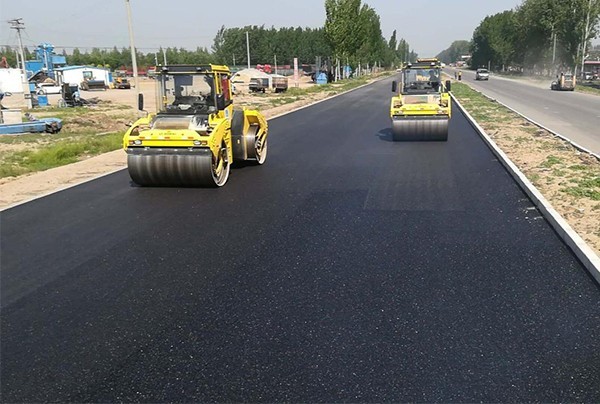BLOG
Talking about the Application of Solvent in Asphalt and Modified Asphalt
Jul 27,2020

Asphalt is a dark-brown complex organic mixture composed of hydrocarbons of different molecular weights and their non-metallic derivatives. It is a black or dark-brown high-viscosity organic liquid, semi-solid or solid at room temperature, and has good adhesion. Resistance, plasticity, impermeability and chemical resistance.
Asphalt is one of the important raw materials indispensable for national infrastructure construction and is widely used in road engineering, construction engineering, water conservancy and hydropower engineering and other fields. Especially in recent years, the explosive development of new electronic, wireless and radar equipment has caused serious electromagnetic radiation interference problems. Especially with the advent of the 5G era, electromagnetic pollution is increasing. In this regard, petroleum asphalt has attracted widespread attention for manufacturing efficient electromagnetic wave absorbing materials due to its low cost and huge output.
In addition, most high-grade highways in the world today use asphalt pavements. Compared with other pavements such as cement, asphalt pavements have the advantages of smooth surface, no joints, good wear resistance, and low noise. application. In recent years, with the rapid development of the national economy, the scale of investment in highway construction has continued to expand and the amount of road asphalt has continued to increase. At present, more than 140,000 kilometers of highways have been built in my country, and about 90% of them have adopted asphalt pavements. Asphalt highways are made of asphalt concrete, of which asphalt accounts for 4%. Assuming that the high-speed six-lane asphalt concrete is 0.19 meters thick and 21 meters wide, the new one-kilometer high-speed asphalt consumption is about 411 tons.
my country's asphalt supply mainly comes from imports and domestic production. In terms of imports, my country is currently one of the world’s largest importers of asphalt. In terms of domestic production, the main production areas of domestic asphalt are in East China, Northeast China and South China. Shandong, Jiangsu, Liaoning, Guangdong, Zhejiang and other provinces account for the country’s asphalt production. About 80%. With the deepening of cooperation among countries along the "Belt and Road" and the increase in infrastructure construction cooperation, domestically produced asphalt is not only supplied to the country, but the total export volume is also increasing. In 2018, there was an explosive growth, which nearly doubled year-on-year.
Classification of asphalt
According to different sources and processing methods, asphalt is mainly classified into coal tar pitch, petroleum pitch and natural pitch.

Coal tar pitch is a black and hardly volatile substance that remains after the tar from the dry distillation of coal, wood and other organic matter. Mainly used in industry, as a waterproof, moisture-proof and anti-corrosion organic cementing material, blending fire oil, producing rubber asphalt and refractory bricks and other products.
Petroleum bitumen is a product in the process of crude oil processing. It is a residue produced after distillation and refining of crude oil. It mainly contains trichloroethylene-soluble hydrocarbons and non-hydrocarbon derivatives. Its nature and composition vary with the source and production of crude oil. It varies from method to method. Most of the asphalt materials mentioned in road construction and construction refer to petroleum asphalt.
Natural bitumen, also called bitumen, is a hydrocarbon mixture containing inert minerals that exists naturally in nature and is stored underground in the form of mineral layers. Mainly used as building materials for civil engineering.
Bitumen in the form of asphalt is obtained by fractionating crude oil. They have the highest boiling point in crude oil and the heaviest substance in crude oil, so they will be found at the bottom of the fractionation tower. The asphalt in the form of tar is obtained by treating organic substances (mostly coal) through dry distillation. In addition, oxidized asphalt, modified asphalt, emulsified asphalt and diluted asphalt will be produced after adding additives to asphalt or further processing.
Asphalt solvent
Asphalt is a complex mixture composed of a wide variety of polycyclic aromatic hydrocarbons. There are hundreds of compounds that can be identified, which results in the complexity of the properties of asphalt. In order to better characterize and apply bitumen, people have developed a variety of methods to separate bitumen, of which the most commonly used method is the solvent grouping of bitumen. The solvent grouping of bitumen separates bitumen based on the difference of the solubility of each constituent compound in bitumen in different organic solvents.

Since bitumen is extracted from petroleum, any oil lighter than bitumen can be used as bitumen solvent, such as gasoline, kerosene, diesel, etc. Asphalt is a hydrophobic material. It is impermeable and almost insoluble in water, acetone, ether, and dilute ethanol. Those who have done asphalt tests should know that kerosene is actually better than diesel, and it is safer than gasoline. In addition, hydrocarbon solvents such as n-hexane and xylene can be used as asphalt solvents. Its application is liquid rubber, a new product in the coating industry, also called spraying quick-setting rubber asphalt waterproof coating.
Choosing appropriate organic solvents such as n-hexane and xylene to treat asphalt can be divided into soluble and insoluble parts. If several solvents with different solubility are appropriately selected, the asphalt can be cut into several with different properties. The solvent component.
Previous Page

